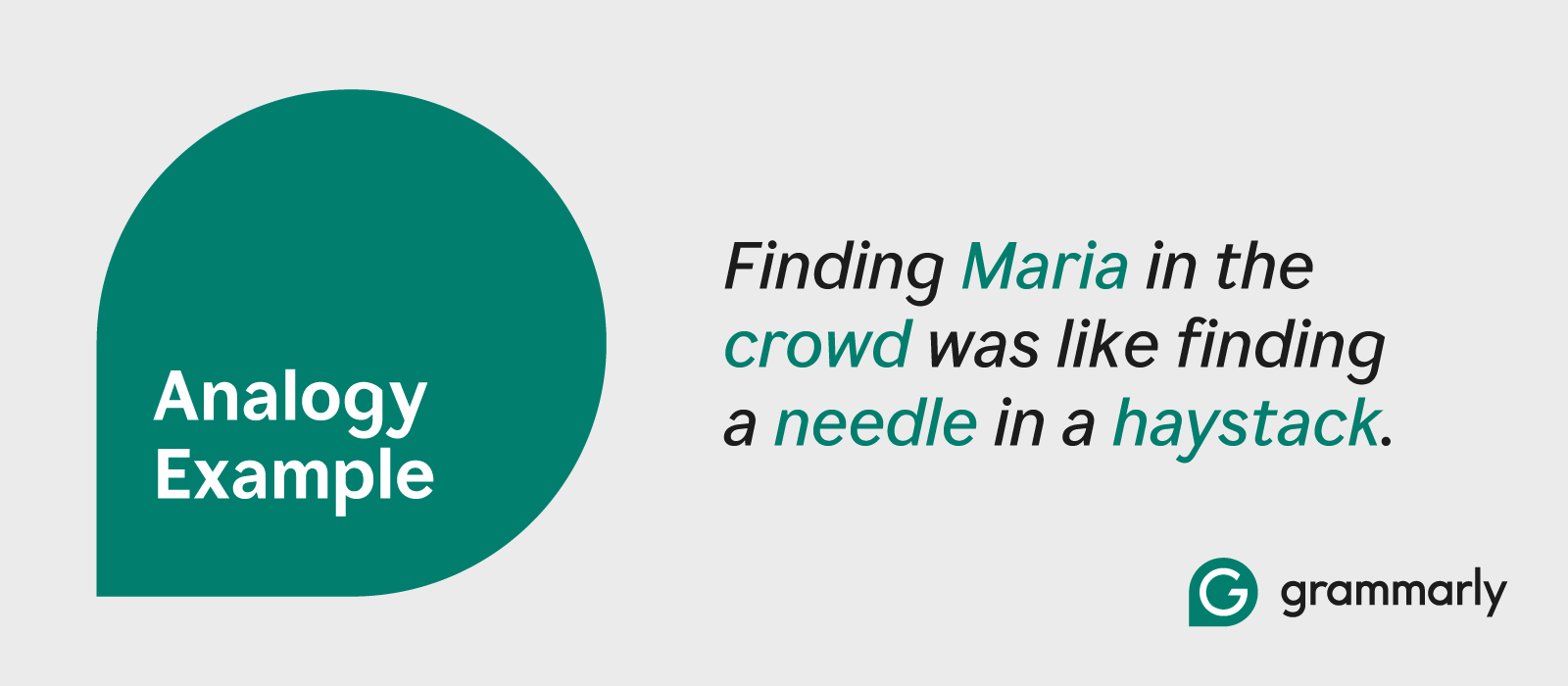
Key takeaways:
- An analogy is a comparison between two different things to explain a concept by highlighting their similarity.
- Analogies are powerful tools used in writing to persuade, explain, or illustrate.
- “Her smile was like sunshine, brightening everyone’s day.” is an example of an analogy.
What is an analogy?
Analogy is a common literary device that draws connections between seemingly unrelated subjects. It aims to explain or clarify concepts by emphasizing their shared relationships or similarities. Analogy can create vivid imagery to engage readers and add personality to writing.
It’s best to deploy analogies to enhance your audience’s understanding of a concept or to strengthen an argument. Sometimes, analogies are written to show a relationship between two pairs of things, like saying, “A relates to B in the same way that C relates to D.”
You might remember this common analogy from biology: “Mitochondria are the powerhouse of the cell.” By comparing mitochondria to a powerhouse—something or someone that is extremely strong, effective, or influential—the analogy conveys that mitochondria are the strongest part of the cell. These two entities aren’t relatable on the surface, but the comparison makes sense when considering their function.

Continue reading to learn more about analogy with examples and usage to enhance your writing.
Table of contents
Types of analogies
There are 11 different types of analogies. Learn more about each in the table below:
| Type of analogy | Definition | Example | Why does the example work? |
| Source to product | Compares a source that transforms, and a product that results from a similar transformation | A sculptor molds their clay similarly to how a baker kneads their dough. | This highlights the relationship between a craftsperson, their raw material, and the final product they create through their skill and effort. |
| Antonyms | Antonyms are about opposite meanings, and their relationship can be portrayed as an analogy when focusing on the structure of opposition. | The weather went from hot to cold as quickly as an elevator goes up and down. | Hot and cold are direct opposites along a temperature scale, like up and down are direct opposites along a vertical axis. |
| Characteristic | Draws a comparison between two different entities based on a shared, prominent characteristic or attribute they possess | The lion’s roar reminded them of rumbling thunder. | Both the roar and thunder share the characteristic of producing a loud, deep sound. |
| Object to function | Compares two different objects based on a similarity in their primary purpose or how they are used | The sharp knife cut through the gristle like scissors through paper. | Both knives and scissors have the primary function of cutting. Despite their different forms and mechanisms, their fundamental purpose is the same. |
| Part to whole | Compares two entities by focusing on how a specific element contributes to the larger structure or system | The mason explained the importance of each brick to constructing the wall, saying each was essential, like every cell in a body. | A brick is a fundamental part of a whole wall, contributing to its structure, just like how a cell is a fundamental part of a whole body. |
| Affective | Compares two things by focusing on the shared feeling or mood the entities elicit, rather than a logical or functional similarity | After the long day, her comforting hug enveloped me like a warm blanket on a cold winter night. | Both evoke a feeling of comfort, warmth, and security, despite being physically different. |
| Cause to effect | Compares two situations based on a similarity in how a particular action or event leads to a specific outcome | I put the same effort into studying, which resulted in good grades, as I did into practicing the piano to improve my skill level. | Demonstrates the parallel between each action and its similar desired outcome |
| Effort & result | Compares two different situations based on the similar relationship between the amount of work or energy invested and the outcome or achievement obtained | The professor weeded her garden to remove unhealthy plants with the same skillful eye she uses to grade essays and correct errors. | Emphasizes how focused work aimed at removing impediments or improving quality leads to a desired positive outcome |
| Object & classification | Compares two different objects by highlighting the parallel relationship between an individual item and the broader category it belongs to | The vibrant red apple stood out in the fruit basket like the rose in the bouquet of flowers nearby. | Showcases the shared relationship of a particular item as a member of a larger, more general category |
| Opposite | Compares two pairs of terms where the relationship within each pair is one of opposition or contrariness | The black-and-white theme evoked the contrast of night and day. | Both pairs illustrate the idea of direct opposition, with the shared relationship at contrasting ends of a spectrum or concept. |
| Simple extended | Builds on a basic analogy by drawing multiple connections between two things, expanding the comparison beyond a single point of similarity | Life is like a journey. It has its ups and downs, with periods of rest and periods of intense activity. Sometimes, we take detours, and sometimes, we reach unexpected destinations. | Takes the initial comparison and dives deeper by highlighting more parallels between the two subjects |
Examples of analogy
There are many examples of analogy in literature, other forms of writing, and speeches. Here are some literary examples of analogy:
| Example | Why is this an analogy? |
|
“Reading poetry is like undressing before a bath. You don’t undress out of fear that your clothes will become wet. You undress because you want the water to touch you. You want to completely immerse yourself in the feeling of the water and to emerge anew.” ―Kamand Kojouri |
Kojouri compares reading poetry to undressing for a bath, showing that both involve vulnerability and a desire for deep emotional or sensory immersion. Just as one bathes to feel renewed, one reads poetry to be transformed. |
| “Truth, like gold, is to be obtained not by its growth, but by washing away from it all that is not gold.” ―Leo Tolstoy | Two unrelated things, truth and gold, are compared in how they are gathered. Tolstoy suggests that you can only obtain gold and truth by removing impurities to uncover something pure and valuable. |
|
“What gunpowder did for war, the printing press has done for the mind.” —Wendell Phillips |
Phillips draws a parallel between the impact of gunpowder on warfare and the printing press on human thought. Both introduced explosive, transformative change—one on the battlefield, the other in intellectual life. |
| “What’s in a name? That which we call a rose, by any other word would smell as sweet. So Romeo would, were he not Romeo called.” —William Shakespeare | Juliet compares a name to a label that doesn’t alter the essence of a thing. Just as a rose would still smell sweet regardless of its name, Romeo’s identity and worth remain the same no matter what he is called. |
How to write an analogy
Analogy is useful when illustrating a point. If you want to use analogy in your writing to help boost understanding, here are four helpful rules:
- Make sure the connection is easy to understand. Creating a complicated analogy defeats the purpose of using it for explanation. Example: “Finding __ is like finding a needle in a haystack” contains familiar and easy-to-understand concepts, despite many people not having experience looking for a needle in a haystack.
- Compare and contrast. Think about how the two things are alike and different. This can help you find the strongest connections for your analogy.
- Think about your audience. For instance, if you’re writing for a younger audience, create analogies with objects and concepts they’ll understand.
- Make immediate connections. To establish understanding, you should present an analogy early in the text.
When to use an analogy
Writers use analogy to give the reader a deeper understanding of a complicated or unfamiliar topic. Use an analogy to explain something complex to your audience or deepen their connection to something in your writing by comparing it to something universally understood.
However, just because an analogy is explanatory doesn’t mean it has to be dull.
By employing figurative language, analogies create understanding while also leaving a vivid impression.
In his novel Beatrice and Virgil, Yann Martel writes: “Just as music is noise that makes sense, a painting is colour that makes sense, so a story is life that makes sense.” This analogy explains the relationship between living and storytelling, and uses expressive language that leaves the reader with a much more memorable sentence.
Increase understanding with analogies
Using analogies in your writing helps your readers understand characters, ideas, and complex topics. The comparisons made through analogy help readers connect to your writing and increase reader engagement by ensuring they understand its contents.
Make your writing more engaging with Grammarly
Grammarly offers writers more than basic spell-check and grammar suggestions. It can help improve sentence structure for clearer writing and explore suggestions for word choice to make your writing more engaging.
However you use it, Grammarly’s real-time recommendations help make your writing process seamless.
Analogy FAQs
Fully understanding analogies is key to crafting successful comparisons within your writing. Learn more about analogy with the answers to some frequently asked questions below:
How does analogy help people understand topics?
Analogy draws parallels between topics by highlighting an understandable similarity. When the similarity is universally understood or a known truth, it allows readers to apply that knowledge to the more complex topic you’re explaining.
For example, we can use analogies to explain lesser-known grammatical devices:
- Anthropomorphism: My dog is acting jealous because I’m paying more attention to my cat, just like a sibling would be jealous of a parent’s attention being given to another of their children.
- False dilemma fallacy: A false dilemma is like believing a light switch can only be turned on or off when, in reality, a dimmer switch may present you with more options.
What is an analogy synonym?
While you should refer to an analogy directly by name when explaining the literary device and how to use it, if you want to avoid repetition, you can use an analogy synonym sparingly.
Analogy synonyms include:
- Comparison
- Parallel
- Similarity
- Relation
- Likeness
- Resemblance
- Correspondence
How does analogy relate to other figurative language?
Analogy is a type of figurative language, similar to other types, especially metaphor and simile. All three figurative devices compare two seemingly unrelated topics to allow readers to develop a deeper understanding of a more complex topic or idea.
When comparing analogy versus metaphor, one rule stands out: a metaphor states that one idea is the same as the other for a direct and simple comparison, while analogy defines the relationship between the two.
For example, “He was a cheetah on the track” is a metaphor. However, “Just as a cheetah uses its lean body and powerful legs to dart after prey, he used his toned physique and muscular legs to propel himself forward in the final sprint” is an analogy.
The same is true when comparing a simile to an analogy, except a simile uses the words “like” or “as” in its comparison. An example of this is “He ran as fast as a cheetah.”






